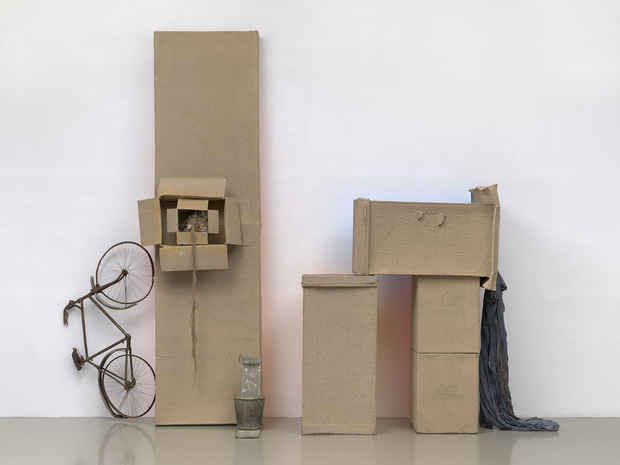Robert Rauschenberg “Venetians and Early Egyptians, 1972-1974”
Gladstone Gallery (Chelsea 21th Street)

This event has ended.
In collaboration with the Robert Rauschenberg Foundation, Gladstone presents an exhibition of rarely seen sculptural works from the height of Rauschenberg’s oeuvre. Spread across Gladstone’s Chelsea galleries, this show reveals Rauschenberg’s significant place in helping to define the history of post-Minimalist sculpture, seeing beyond what others decided should be the limits of art.
Rauschenberg (1925 - 2008) famously stated that “painting relates to both art and life,” and he wished to work within the “gap between the two.” For over sixty years, Rauschenberg traveled, collaborated with performers and artists, and worked through many subjects, mediums, and techniques to find and understand art’s meaning. Born in the small town of Port Arthur, Texas, Rauschenberg went on to serve in the US Navy. With the assistance of the GI Bill, he studied at the Kansas City Art Institute and the Academie Julian in Paris. In 1948, he enrolled at the highly influential Black Mountain College, where he studied under Josef Albers and communed with like-minded artists including his future wife Susan Weil, Cy Twombly, John Cage, and Merce Cunningham, whom he would go on to collaborate with in New York and around the world.
From the start, Rauschenberg was an artist who pushed beyond the traditional idea of working in a single medium. Reminiscent of his found-object Combines of the 1950s and 1960s, the Venetian and Early Egyptian series blur the line between sculpture and painting, between waste and conservation, and between everyday objects and artworks. The exhibition at Gladstone Gallery will be one of the first focused exhibitions on these works since their debut at Leo Castelli gallery in 1972 and 1973.
In 1970, Rauschenberg left New York City and relocated to the remote island of Captiva off the Gulf Coast of Florida, where he remained for nearly four decades. With the move came a new palette of readily accessible materials that embodied a shift away from motley urban density toward rural seclusion. On view are key works from Rauschenberg’s historic Venetian series (1972–73). In the spring of 1972, Rauschenberg accompanied his dealer at the time, Ileana Sonnabend and her husband on a trip to Venice. While in Italy, Rauschenberg was struck by the juxtaposition of the city’s grandeur and elegance, in contrast to its concurrent fragility and decay. In the works on view, Rauschenberg uses the technique of assemblage, incorporating a range of household and natural found objects, from leather and rubber, to wood utility poles and tire treads, bringing them together in strange yet poetic formations. Immersing these common objects in an artistic dimension and following the Dada and Duchampian concept of the Readymade, these works function as a point between art, life, painting, assemblage, and everything in between.
Inspired by the surroundings of his coastal studio, Rauschenberg made new bodies of work, including the Early Egyptian series (1973–74). Radically different from his earlier practice, these works orchestrate the no color, neutral tonalities of sand, wood, bicycle wheels, and cardboard into ascetic opulence. While imageless, viewers still encounter signature Rauschenberg objects including repurposed furniture and the tire tread he made iconic. Reflecting on cardboard’s varied historical, cultural, and economic properties, Rauschenberg shrouded and transformed the material in the Early Egyptian series. Reminiscent of his Elemental Sculptures of the 1950s, these works play with the idea of trompe l’oeil, employing cardboard, glue, and sand as analogous to stone and sediment. In Untitled (Early Egyptian) from 1974, four large rectangular boxes standing side by side are all painted a bright, reflective orange on the back, casting a colored glow on the wall behind. They are propped up by smaller cardboard boxes covered in sand, and bring to mind the Great Sphinx of Giza in form and composition. It in fact references a motif of four sun-worshipping baboons that once formed the pedestal for an obelisk in Luxor, now in the Egyptian collection of the Louvre, where Rauschenberg saw it and made this work in response. Engaging affordable and accessible material, Rauschenberg was able to create works that recall the great Egyptian temples, or in other cases, a towering angular mummy sarcophagus. Inspired by his interest in ancient Egypt, Rauschenberg transformed the cardboard material, which is associated with waste, consumerism, and labor, into luminous and precious artifacts, containers for nothing that recall so much of the past.
This exhibition is presented in cooperation with the Robert Rauschenberg Foundation. Two other gallery exhibitions coincide with Robert Rauschenberg: Venetians and Early Egyptians, 1972-1974 at Gladstone: Robert Rauschenberg: Exceptional Works, 1971-1999 at Mnuchin Gallery from May 3 - June 11, 2022 and Robert Rauschenberg: Japanese Clayworks at Galerie Thaddaeus Ropac, Salzburg from April 8 - July 9, 2022.
Media
Schedule
from May 04, 2022 to June 18, 2022
Opening Reception on 2022-05-04 from 18:00 to 20:00